When the January transfer window opened, Sturm Graz decided to cash in on their star striker, Kelvin Yeboah; when Genoa, under new manager Alexander Blessin, decided to spend €6.5 million to bring Yeboah to northern Italy. After selling their main striker, Sturm Graz looked to Denmark for their next young forward, bringing in 19-year old Dane Rasmus Højlund from FC København for a fee of around €1.8 million.
During the first half of the season in Denmark, Højlund managed 26 appearances (mostly substitute appearances) across all competitions for København, with 5 goals. Since moving to Austria, Højlund has started in every match for Sturm Graz, managing 6 goals and 1 assist in ten appearances. This tactical analysis and scout report piece will take a look at some strengths developing in Højlund’s game, analysing them in detail.
Position overview
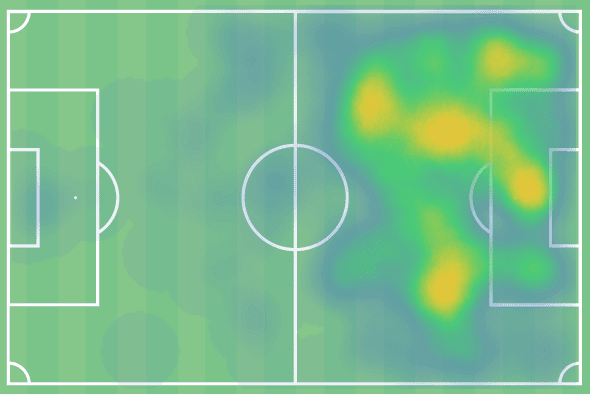
As shown above from Højlund’s heat map during his short time in Austria with Sturm Graz, he is not just a target centre-forward that stays in and around the 18-yard box. Højlund also likes to drop deeper into midfield, finding pockets of space in order to receive the ball. He likes to get heavily involved in the build-up play, using his height to be able to win first and second balls, as well as holding up play to allow runners to get beyond him. Højlund will also drift wide at times as well, allowing space centrally for midfield runners to move into the box to get into better attacking positions. However, Højlund is still a prototypical centre-forward, one that wants to score goals, which he has excelled at with Sturm Graz so far.
Intelligent movement in and around the penalty box leads to good shot selection and goal scoring chances
This first section will more so look at two strengths in Højlund’s developing game: intelligent movements in and around the penalty box and his shot selection. Højlund is selective when it comes to the positions that he attempts shots from, and this is illustrated by his 6 goals for Sturm Graz already from only 10 appearances. He is also attempting 2.15 shots per 90 with Sturm Graz, with 52.2% of them being on target. This selective shot selection originates from the smart movements that he makes to find space for himself to take these shots on. Though this is a smaller sample size, and it is bound to probably decrease slightly as he accumulates more game time for Sturm Graz; the early signs are promising when it comes to Højlund’s shot selection and clinical goal scoring ability.
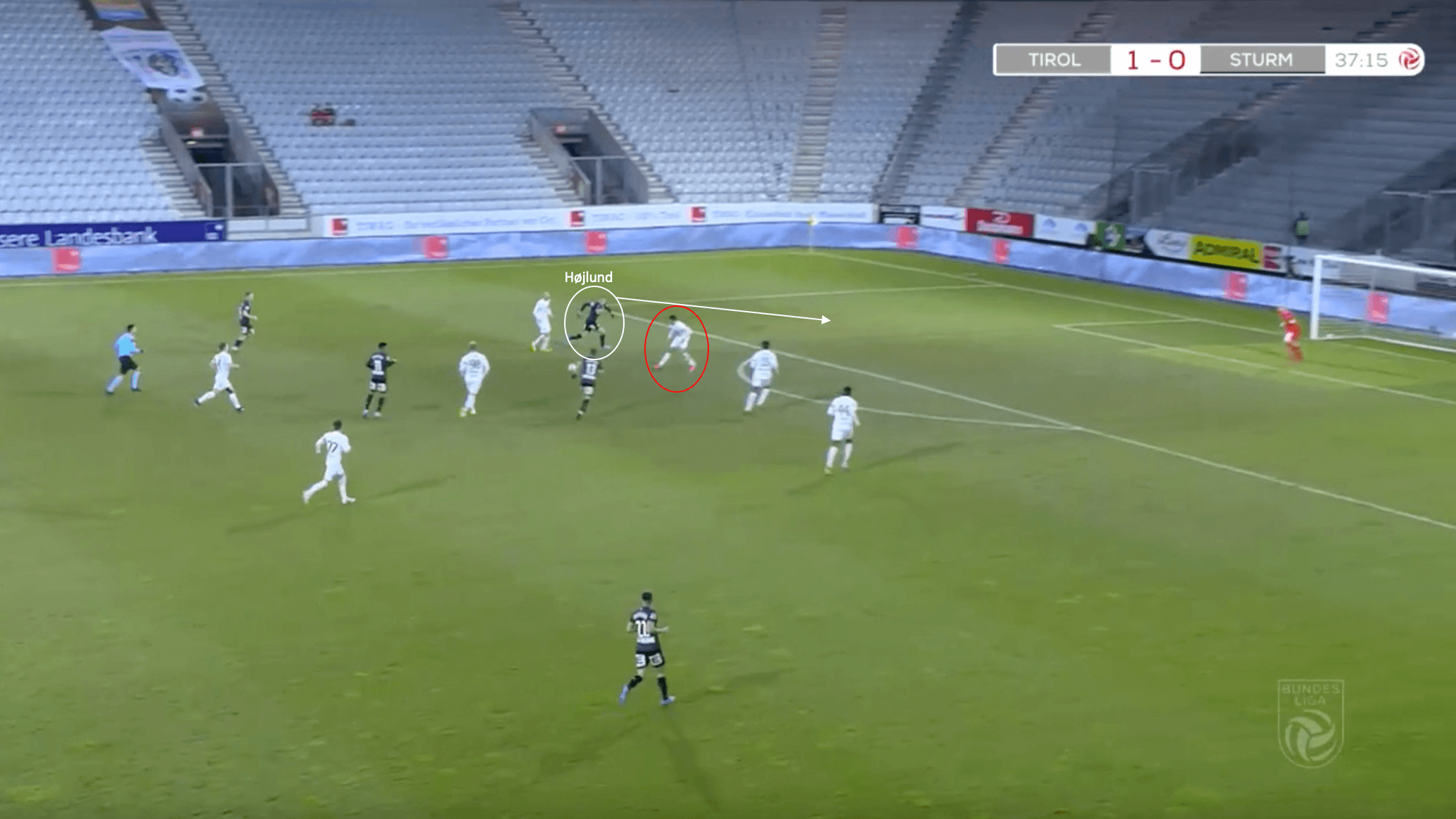
The image above shows an example of this intelligent movement and finishing ability developing in Højlund’s game. Højlund has positioned himself on the shoulders of the last defenders in the opposition’s defensive line. He notices the centre-back ball watching, and makes a run in behind. He is able to get through unmarked, and stays calm and collected to send a shot past the goalkeeper into the far bottom corner. This was actually Højlund’s first-ever goal for Sturm Graz, and it demonstrated the type of centre-forward that he is, with his intelligent movements in and around the 18-yard box helping him create goal-scoring chances for himself.
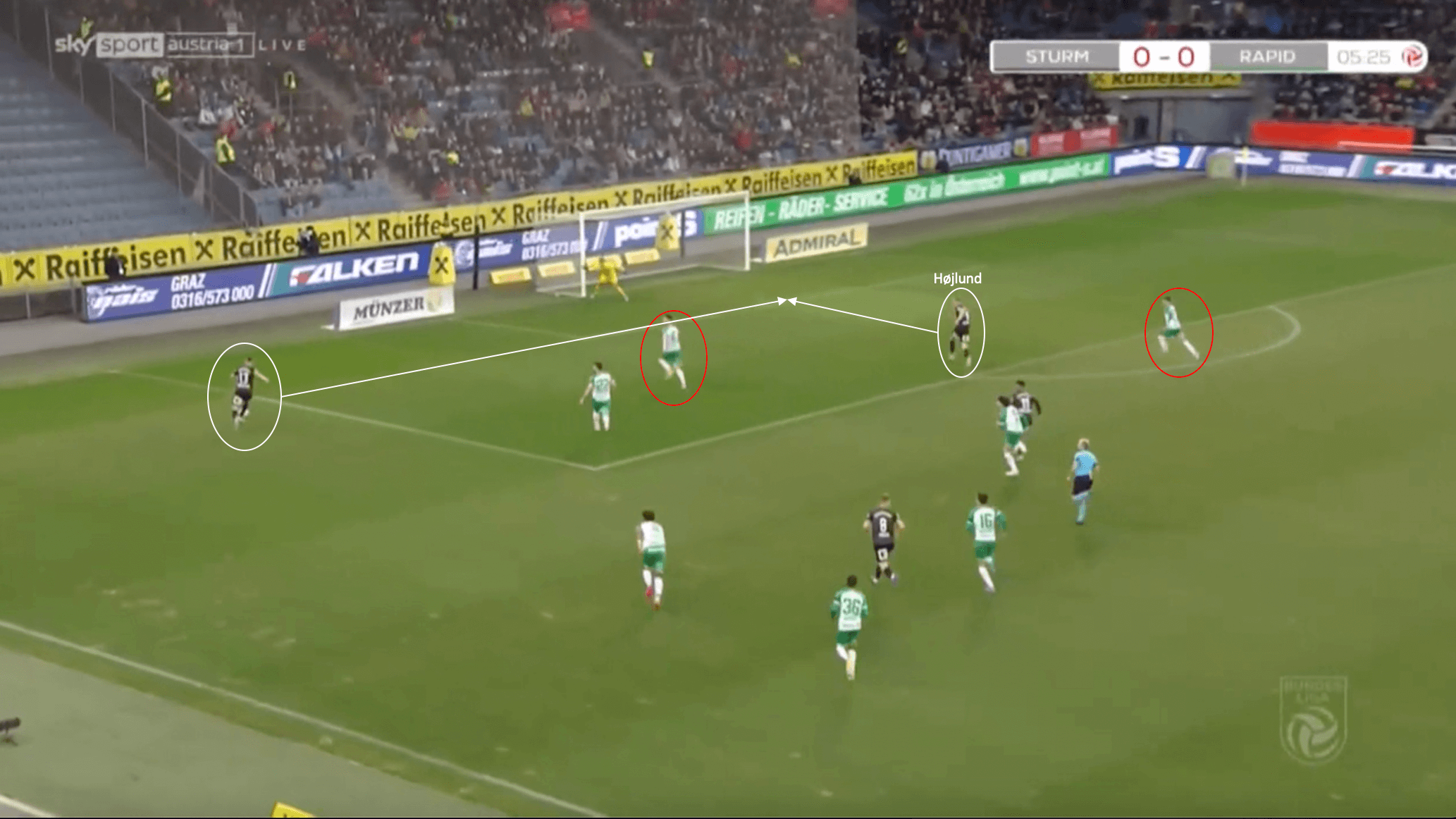
The image above shows another example of the intelligent movements that Højlund makes to create space for himself for teammates to find with passes and crosses into this space. In the phase of play above against Rapid Wien, Højlund started his run from outside the penalty box, and was able to find the space in between the two Rapid centre-backs. He proceeds to run into that space towards the edge of the six-yard box, which allows the Sturm Graz player in possession out wide to play a cross into Højlund’s path. As a result, Højlund is able to tap the ball into essentially an empty net, giving Sturm Graz the lead. Another thing to note is that Højlund is the only player positioned inside the 18-yard box, and even with three Rapid defenders in relatively close proximity to him, he was still able to ghost into the space for a tap-in. Though that could be put down to Rapid Wien’s poor defensive positioning in this transitional moment, some credit still has to go to Højlund for taking advantage of this defensive lapse from Rapid.
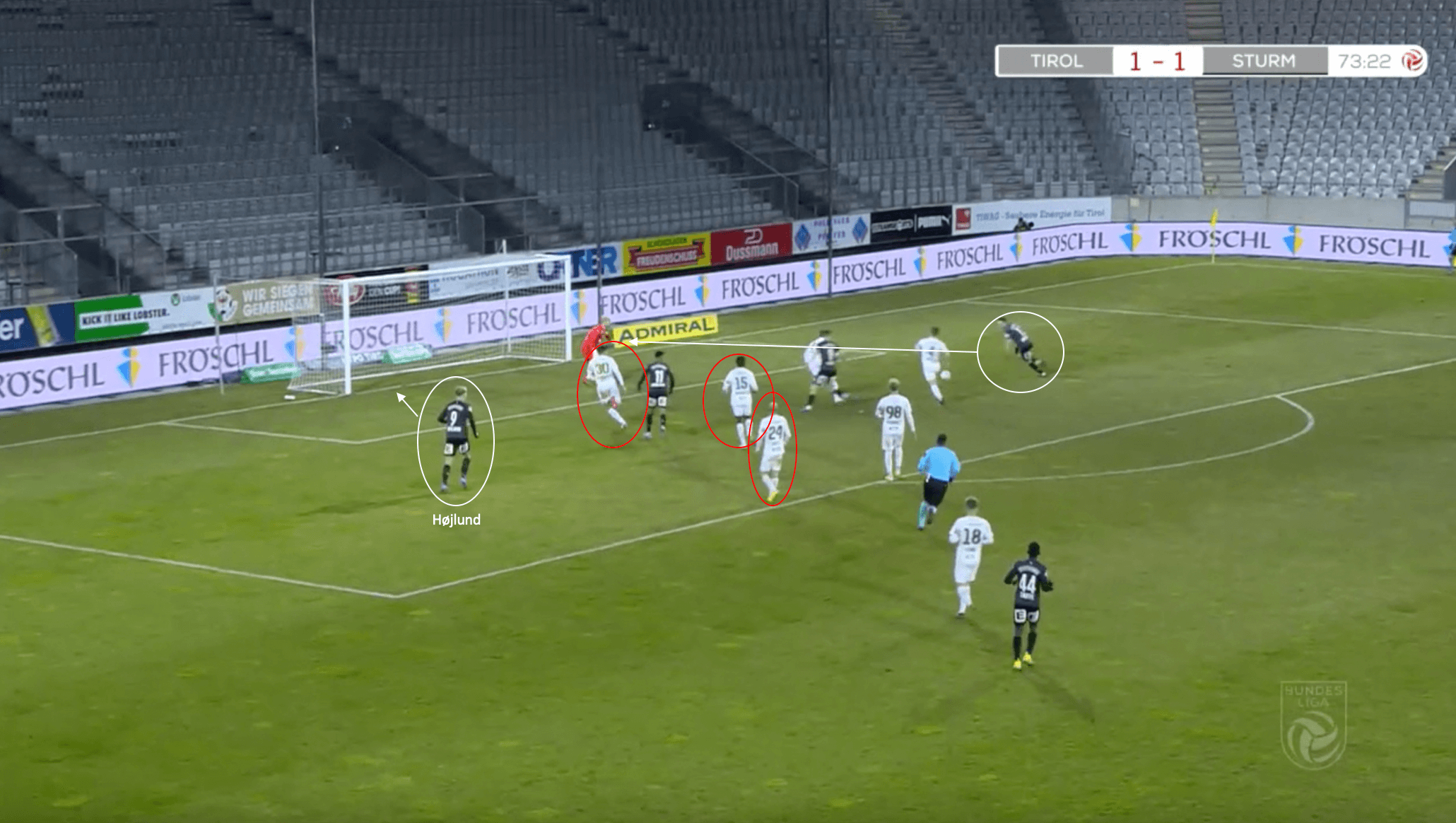
The attacking phase from Sturm Graz above once again shows the types of positions that Højlund looks to try and occupy at times when inside the penalty box. Here, Højlund is able to drift away from his marker and find himself unmarked at the back post. The Sturm Graz player in possession fires a shot at the goalkeeper, who is able to save. The ensuing save is parried into the path of Højlund, who because of his positioning, is able to tap in the rebound at the back post. Thanks to his intelligent positioning and movement near the 6-yard box, Højlund is able to find himself on the score sheet again.
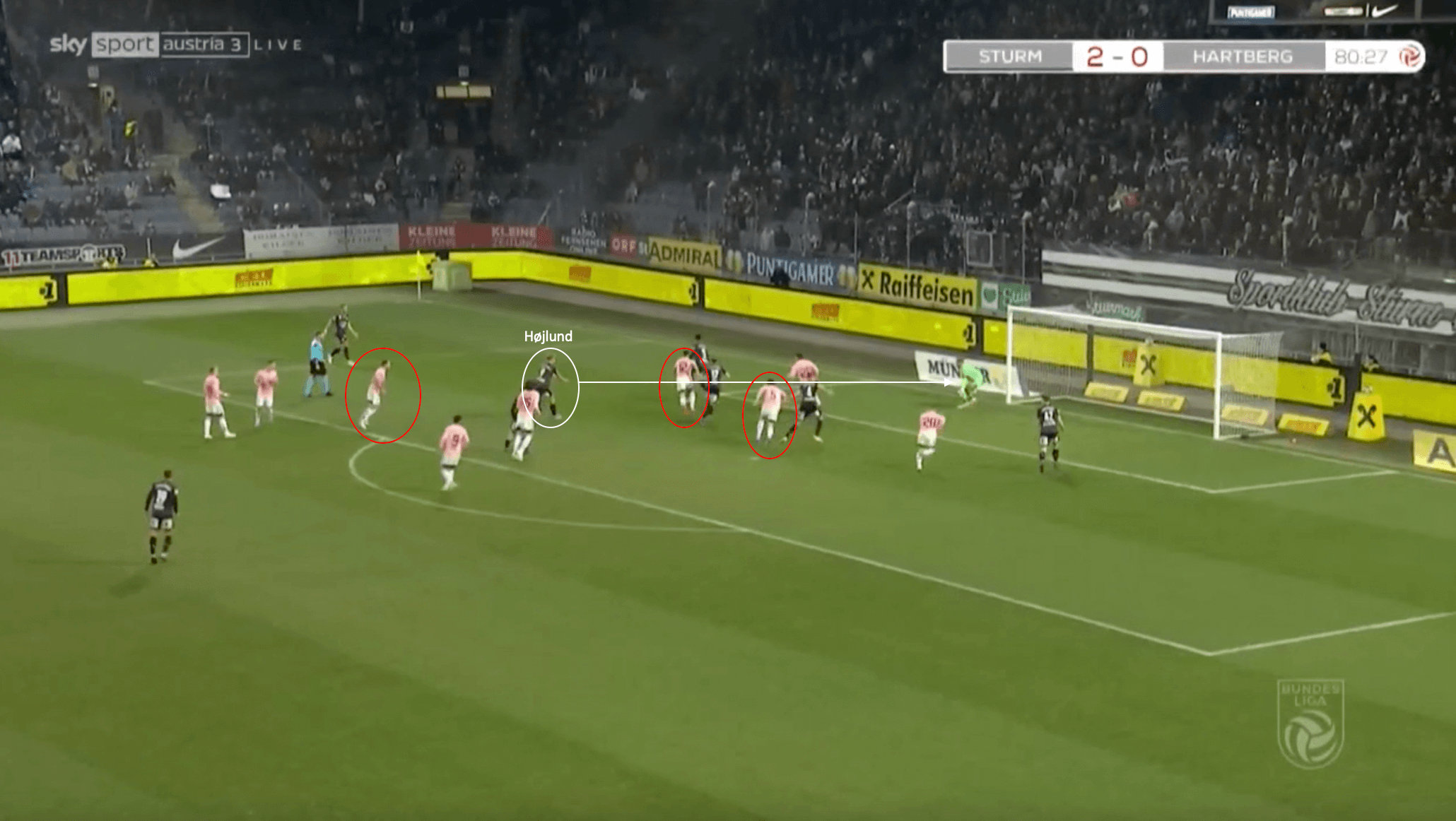
The final example for this section once again shows Højlund’s ability to intelligently drift away from defenders to find himself in shooting positions. In the phase of play against Hartberg, the ball is headed back into the box after an initial defensive clearance from a Hartberg defender. The ball finds its way to the edge of the six, and with the defenders caught ball watching, Højlund is able to drift centrally unmarked. The ball is played to him, but unfortunately, his ensuing shot is saved by the goalkeeper.
Being a clinical finisher is something that needs to be partnered with the ability to make intelligent runs in and around the opposition’s penalty area, as well as good shot selection. Though still young and developing as a centre-forward, Rasmus Højlund has so far been able to develop and utilise these skills to a high level.
Involvement in link-up play
This next section will take a look at Højlund’s developing ability to be involved in link-up play, and dialogue with his midfielders as a result. As his heat map from his time with Sturm Graz so far has shown, Højlund likes to drop into deeper positions in midfield, being involved in the link play as well as attempting to hold-up the ball to allow runners to move beyond him. So far in his time in Austria, Højlund is attempting roughly 16 passes per 90 minutes, with a success rate of 70.2%.
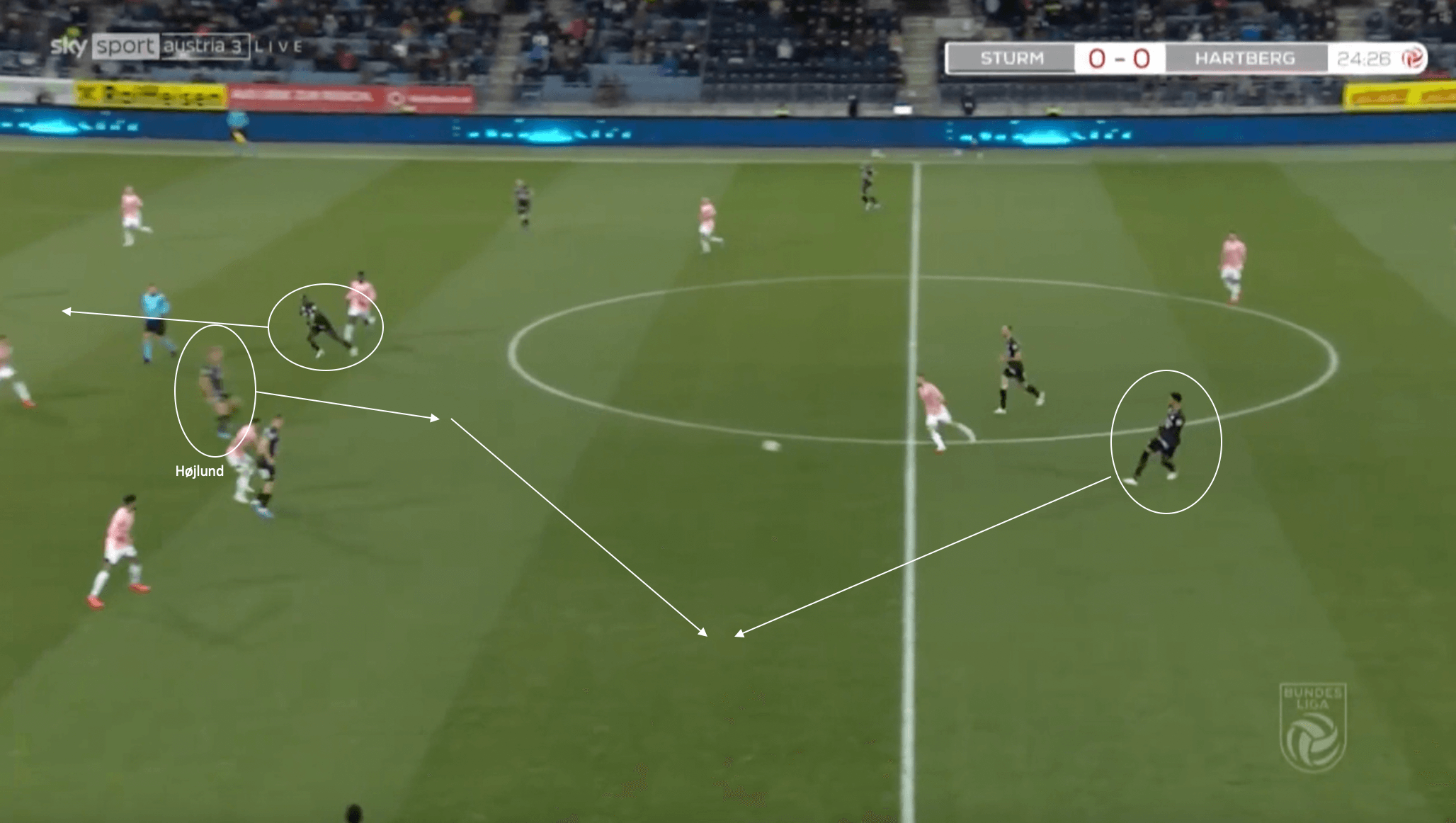
The image above shows a good example of Højlund’s involvement when it comes to link-up play. In this phase of play against Hartberg, Højlund drops into midfield, finding the space between the opposition lines. His movement into this deeper position also facilitates the run of the midfielder, who moves into the space he left. The ball is played to Højlund, who is able to take a touch before passing it into the space that the centre-back moves into.
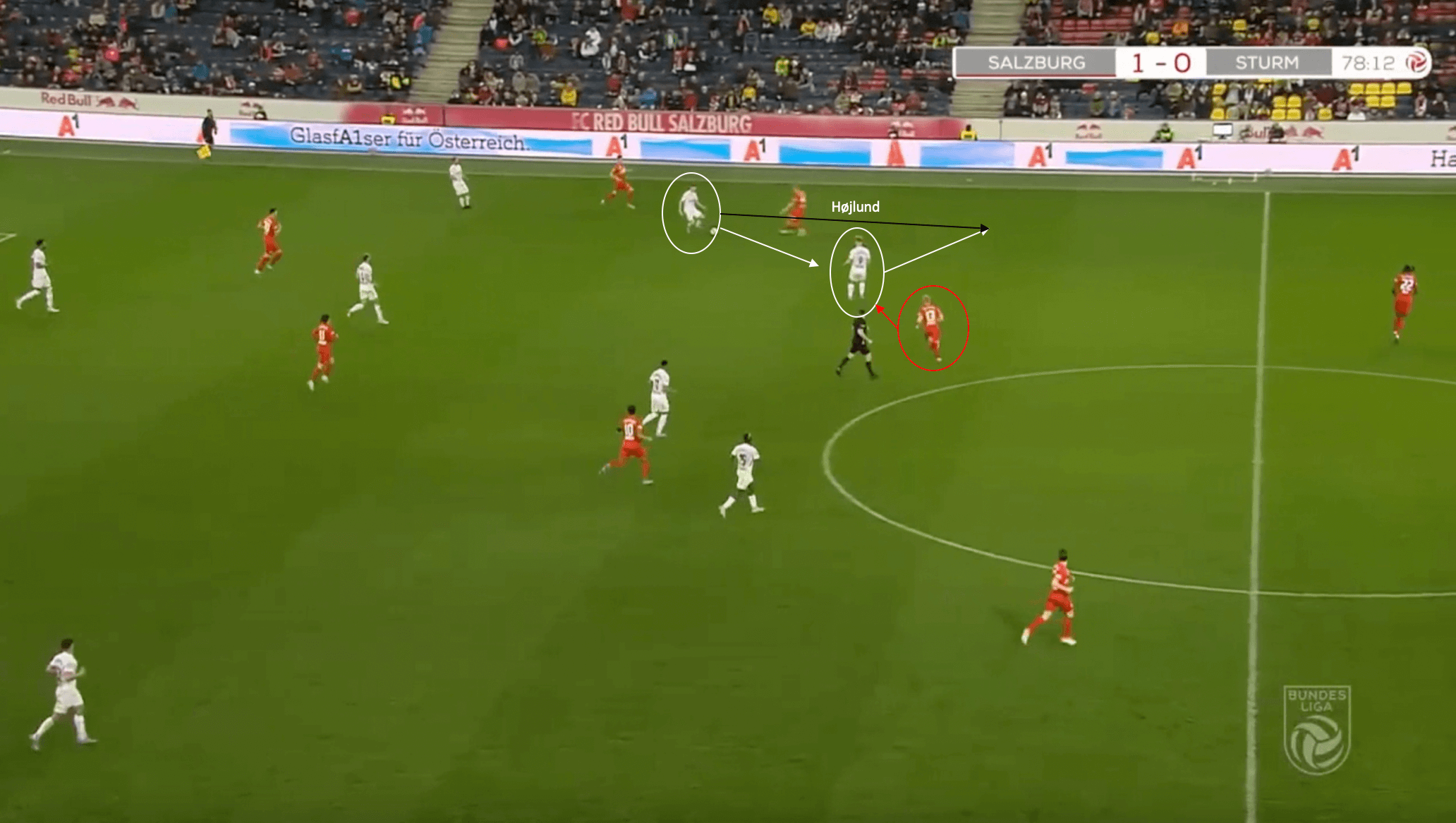
The phase of play above from Sturm Graz’s match against FC Salzburg demonstrates another example of Højlund’s tendency to drop into deeper positions to assist during build-up. With Salzburg’s tendency to press high when out of possession, Højlund drops into the defensive third of the pitch to assist his teammate in possession. The ball is played to Højlund, who is then able to play a one-two with his teammate, passing first time into the space. He accomplishes this even with the pressure from the Salzburg midfielder from behind him; and as a result, is able to help break through the Salzburg press.
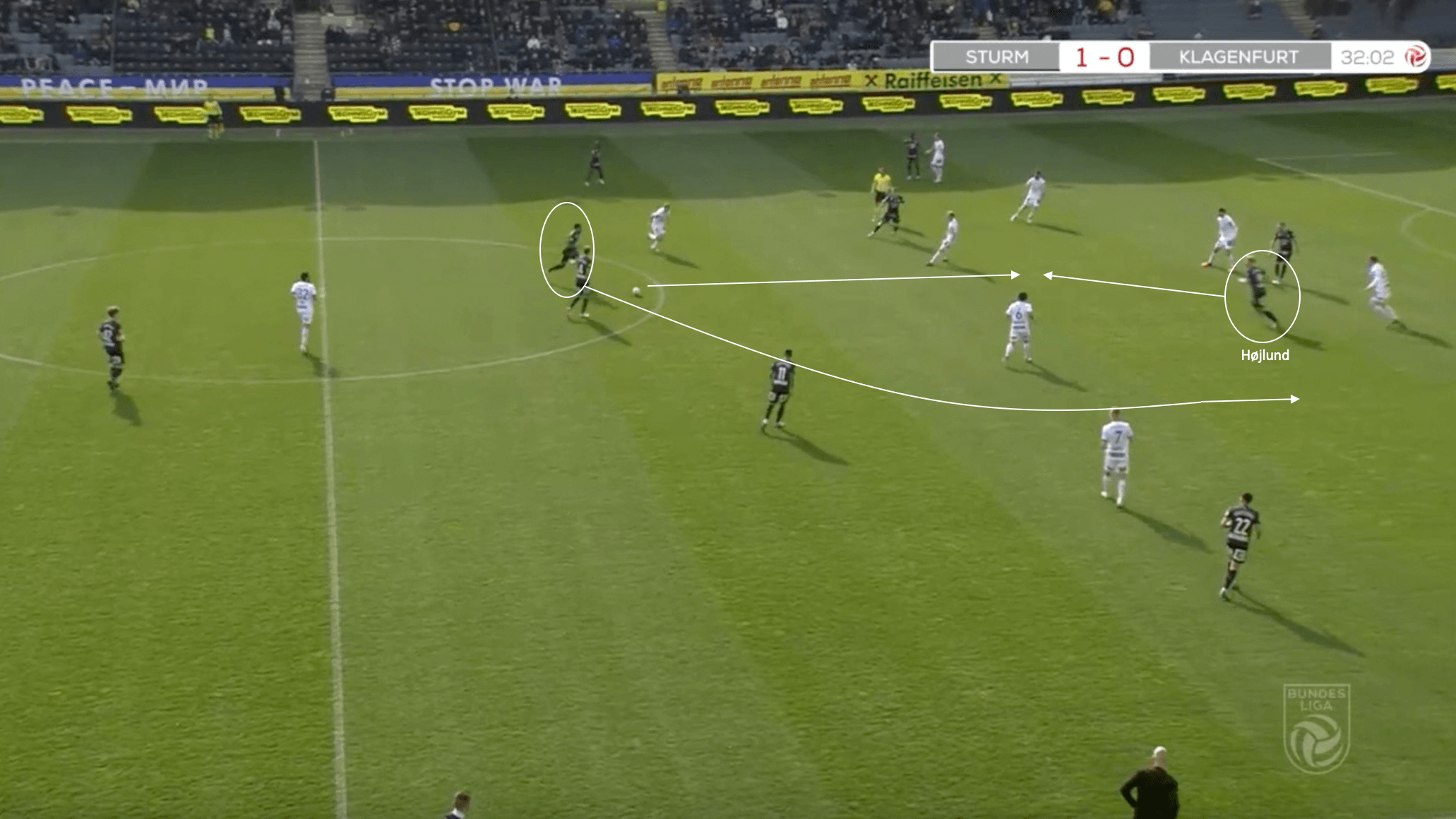
The image above shows another example of this tendency to drop into deeper positions for Højlund. Here, he notices the pocket of space between the opposition lines and drops into it. The ball is played to Højlund, who is then able to play a first time backheel pass into the path of the runner who runs beyond him from deep. After the back heel pass, Højlund is able to quickly get back into an advanced attacking position, becoming an option on the edge of the box.
Though not the strongest side of his game, Højlund’s tendency to drop into the pockets of space between the lines during build-up phases has allowed Sturm Graz to break opposition presses more; as well as be able to use Højlund’s ability to hold up the ball to allow runners to get beyond him into more advanced positions.
Aerial ability
Another strong attribute that Rasmus Højlund possesses is his presence aerially. Standing at 6’2”, Højlund is normally the favourite going into aerial duels against opposition defenders. With that being said, he could slightly improve his success rate. Since moving to Sturm Graz at the end of January, Højlund is averaging 8.9 aerial duels per 90, with a success rate of 40%. Though not a low number, it would still be nice to see this number improve to even just slightly over 50%, which would help Højlund become even more prominent of a threat aerially on a consistent basis.
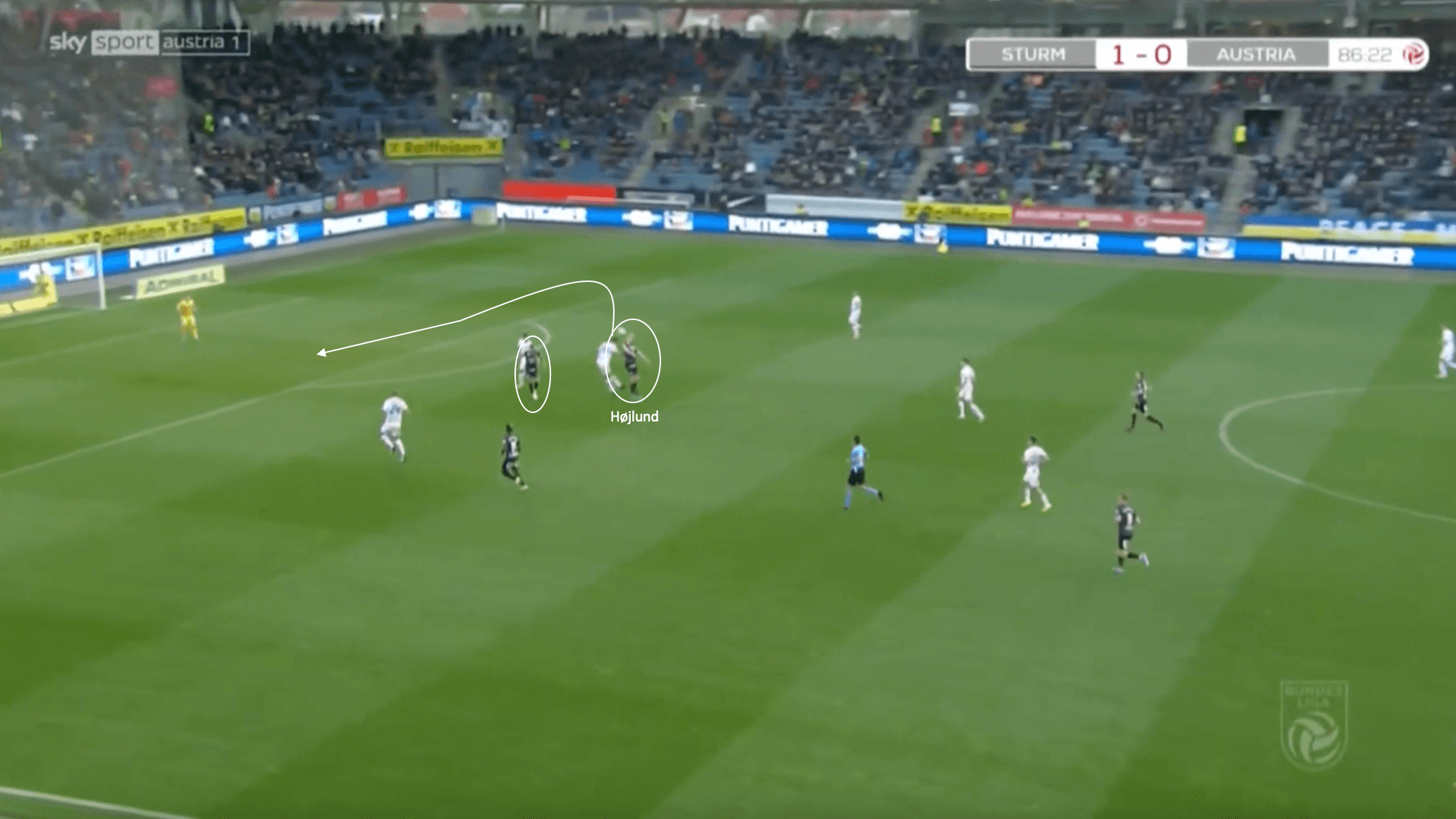
The image above from Sturm Graz’s match against Austria Wien shows what Højlund is capable of aerially when at his best. The ball is played long by the goalkeeper from a free-kick, looking for Højlund. He is able to outjump the defender, winning the ball and flicking it into the space behind the backline. Unfortunately, his teammate does not make a run into the space in behind, allowing the goalkeeper to calmly collect the flick-on.
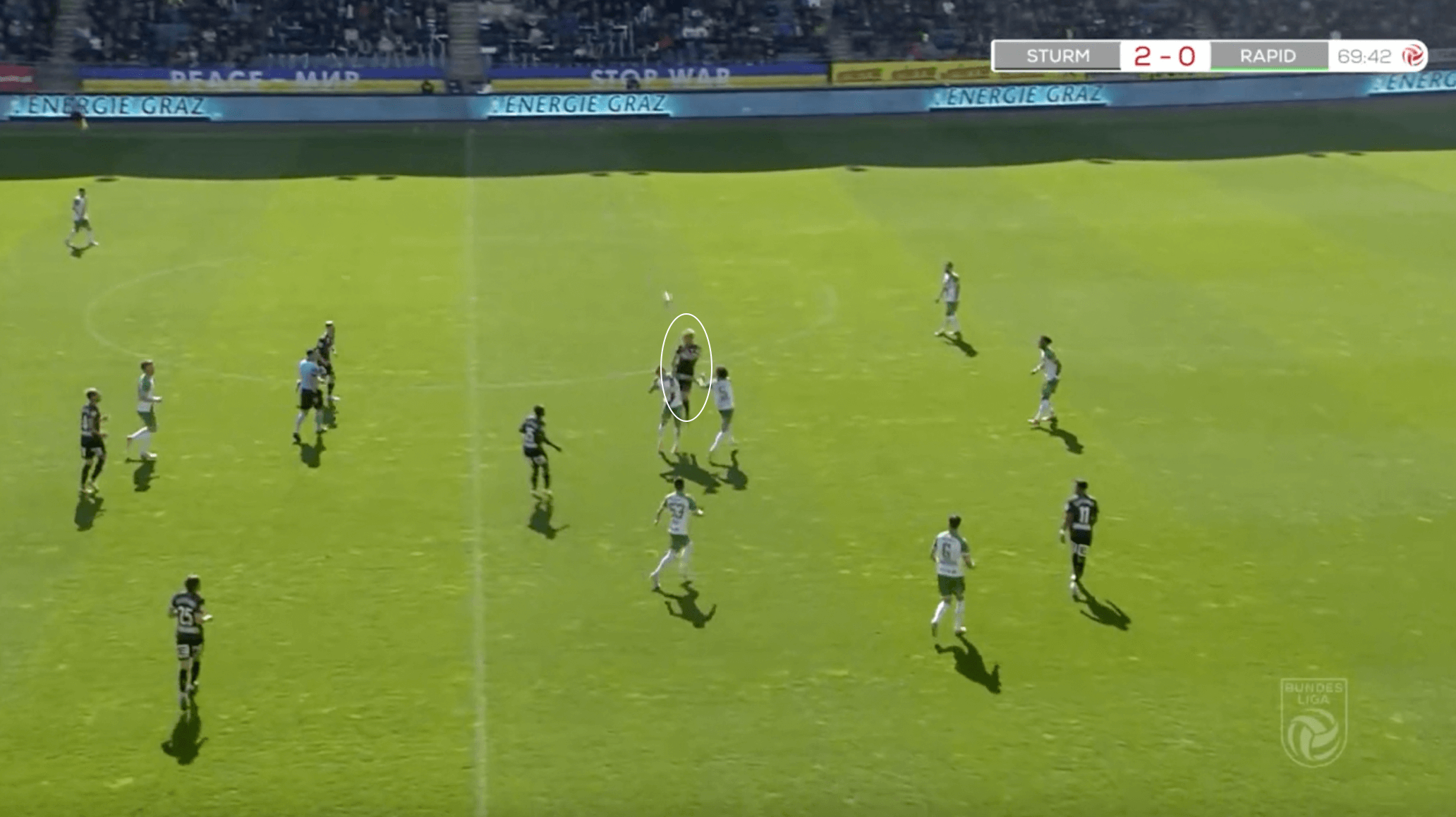
This image once again shows the type of presence Højlund is capable of being aerially. The ball is played long from the goalkeeper towards where Højlund is positioned. He is easily able to outjump both Rapid Wien players, and even though the second ball falls to a Rapid player because of the lack of options for Højlund to attempt to head to, it still demonstrates the ease at which Rasmus Højlund can win aerial duels when he is at his best in this department.
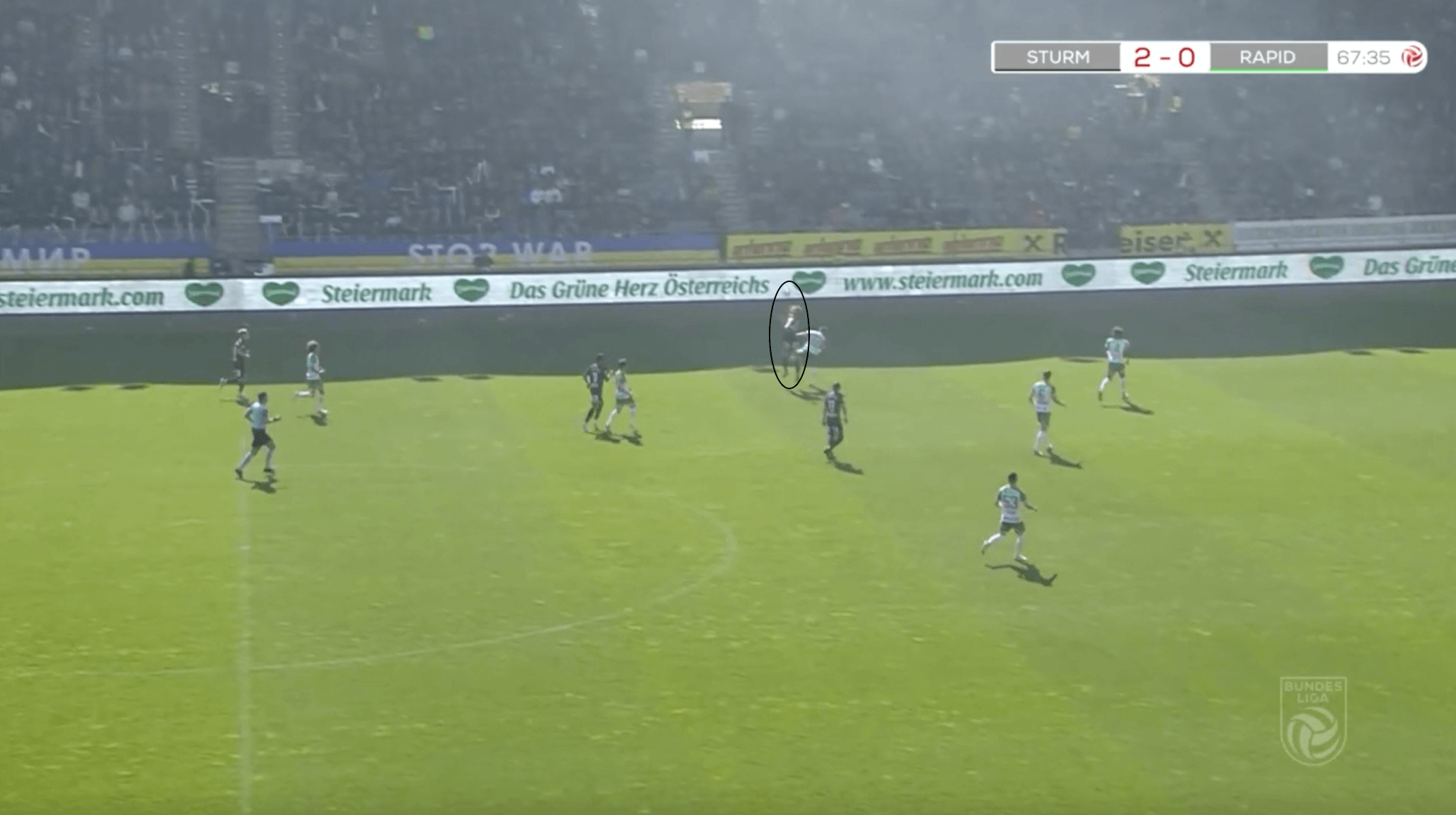
Once again, the image above shows how Højlund is able to position himself against the defender in goal kick situations. He is able to get in front of the defender and block him off, allowing him the momentum to get up and win the header. Højlund is able to flick the header on, but it falls to the Rapid defender. However, Højlund is able to use his work rate to close the defender down, winning the ball back for Sturm Graz in the process.
This final section was able to take a little look at the aerial presence that Rasmus Højlund provides for Sturm Graz; with him usually being the main target when Sturm Graz look to play the ball long off of goal kicks or clearances. While his aerial ability could slightly improve, he still is able to use it to his advantage in most situations.
Conclusion
At only 19 years of age, Rasmus Højlund is without a doubt still developing as a centre-forward. While he did not get the most opportunities during his time with FC København, at Sturm Graz he has become one of their key contributors in the second half of the season, as this tactics and analysis piece has shown. Though he has not been in Austria for a full season yet, it would not be surprising if bigger clubs of the ilk of Ajax or Borussia Dortmund start having a close look at Højlund’s development. If Højlund is able to keep this form going, it would also not be a surprise if a senior Danish national team call-up comes in the near future. What is certain is that with a full season at Sturm Graz, Rasmus Højlund will continue to develop into a more complete centre-forward.





Comments